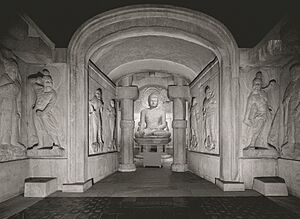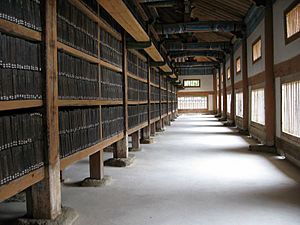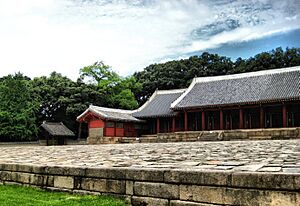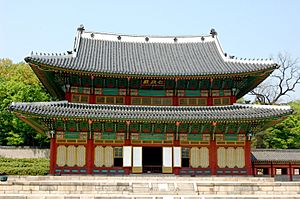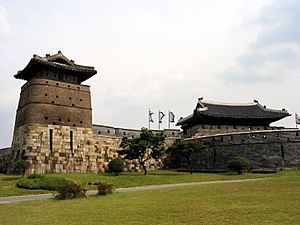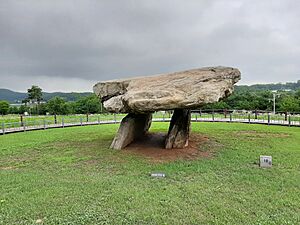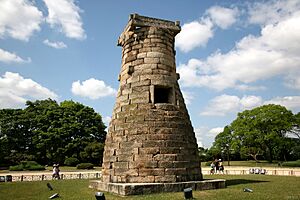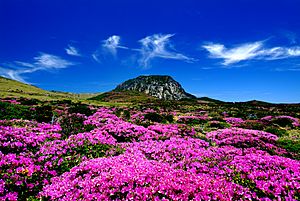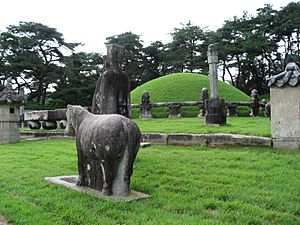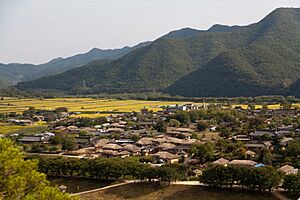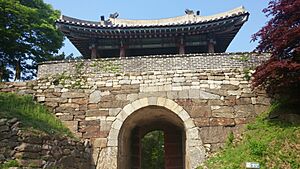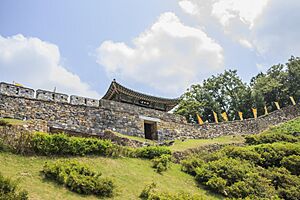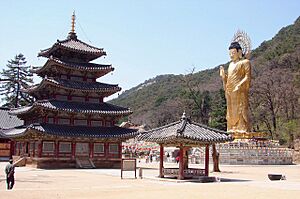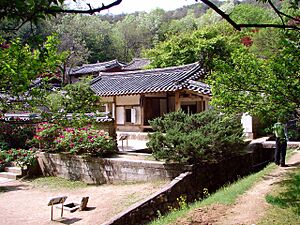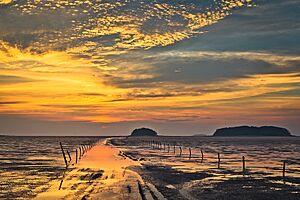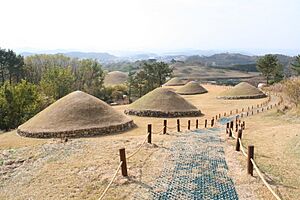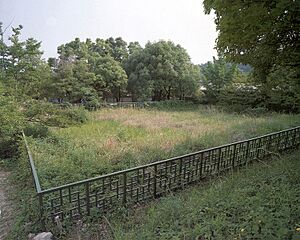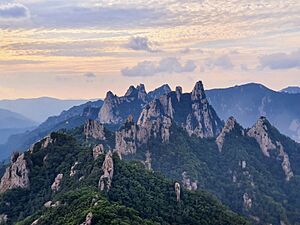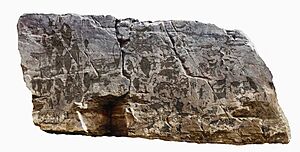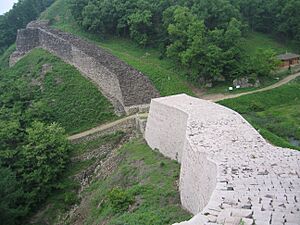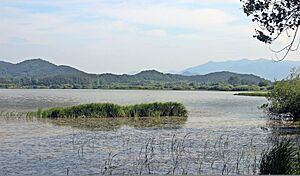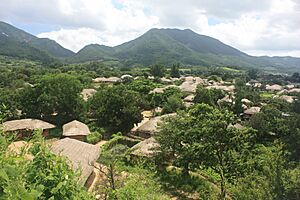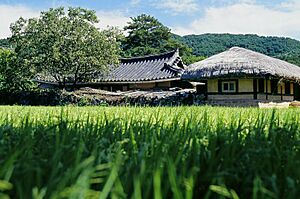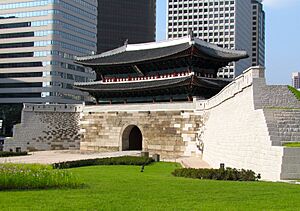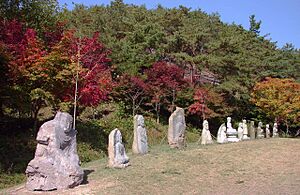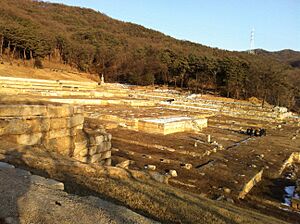List of World Heritage Sites in South Korea facts for kids
UNESCO stands for the United Nations Educational, Scientific and Cultural Organization. This group helps protect important places around the world. These places are called World Heritage Sites. They can be important for their history, culture, or natural beauty.
A place is chosen as a World Heritage Site if it has special cultural or natural value. Cultural sites include old buildings, sculptures, or archaeological areas. Natural sites are amazing places like mountains, forests, or areas where rare animals and plants live.
South Korea joined the UNESCO agreement in 1988. This meant its special places could be added to the list. As of 2023, South Korea has 16 World Heritage Sites. There are also 12 more sites that might be added in the future.
The first three sites in South Korea were added in 1995. These were Haeinsa Temple, Jongmyo Shrine, and Seokguram Grotto with Bulguksa Temple. The newest site, Gaya Tumuli, was added in 2023. Most of South Korea's sites are cultural, but two are natural: Getbol and the Jeju Volcanic Island and Lava Tubes.
Contents
Amazing World Heritage Sites in South Korea
UNESCO lists sites based on ten different rules or "criteria." Each site must meet at least one of these rules. Rules 1 to 6 are for cultural sites, and rules 7 to 10 are for natural sites.
| Site | Image | Location (Province) | Year listed | UNESCO data | What makes it special |
|---|---|---|---|---|---|
| Seokguram Grotto and Bulguksa Temple | North Gyeongsang | 1995 | 736; i, iv (cultural) | This Buddhist site was built in the 8th century during the Silla kingdom. The Seokguram Grotto is an amazing artificial cave made of granite. It has a large Buddha statue and is a masterpiece of Buddhist art. Bulguksa Temple was finished in 774. It has many wooden buildings on stone terraces. Both the temple and grotto have been carefully fixed up over time. | |
| Haeinsa Temple Janggyeong Panjeon, the Depositories for the Tripitaka Koreana Woodblocks | South Gyeongsang | 1995 | 737; iv, vi (cultural) | The Tripitaka Koreana is a huge collection of over 80,000 wooden printing blocks. They were carved in the 13th century. These blocks hold the most complete collection of Buddhist writings, laws, and agreements. Haeinsa Temple was built in the 15th century just to store these blocks. It used smart ways to keep them safe. The temple is also a very important place for Buddhist pilgrims. | |
| Jongmyo Shrine | Seoul | 1995 | 738; iv (cultural) | Jongmyo Shrine is a Confucian royal shrine. It holds the spirit tablets of kings and queens from the Joseon Dynasty. It was first built in the 14th century but was destroyed during a Japanese invasion. It was rebuilt in the early 17th century and still looks much the same today. Special ceremonies to honor ancestors are still held here. | |
| Changdeokgung Palace Complex | Seoul | 1997 | 816; ii, iii, iv (cultural) | This palace was built in the 15th century during the Joseon Dynasty. It was burned down during a Japanese invasion but was quickly rebuilt. For 250 years, it was the main home for the kings. The palace design follows Confucian ideas. It has gates, courtyards, and living areas. This palace greatly influenced Korean architecture and garden design. | |
| Hwaseong Fortress | Gyeonggi | 1997 | 817; ii, iii (cultural) | This fortress, made of stone and brick, was built in the late 18th century in Suwon. King Jeongjo ordered its construction. It uses military ideas from Europe and East Asia. It has floodgates, watchtowers, and bunkers. The fortress was used for defense, government, and trade. Most of it is still standing today. | |
| Gochang, Hwasun and Ganghwa Dolmen Sites | Incheon, North Jeolla, South Jeolla | 2000 | 977; iii (cultural) | This site has three groups of dolmens. Dolmens are large stone monuments used as tombs by people in the Neolithic and Bronze Age. Korea has the most dolmens in the world. Different types of dolmens teach us about the cultures and rituals of the people who built them long ago. | |
| Gyeongju Historic Areas | North Gyeongsang | 2000 | 976; ii, iii (cultural) | The Silla kingdom ruled Korea for many centuries. This site shows remains of their Buddhist temples, palaces, and other buildings. The stone statues, carvings, and pagodas are amazing examples of Buddhist art from the 7th to 10th centuries. The Tumuli park has royal tombs, like the Flying Horse Tomb. Digging up these tombs found rich gold, glass, and ceramic treasures. Cheomseongdae, an old observatory from the 7th century, is also here. | |
| Jeju Volcanic Island and Lava Tubes | Jeju | 2007 | 1264bis; vii, viii (natural) | Jeju Island is a volcanic island at the southern tip of Korea. It's a shield volcano with cool features like lava tubes and the Seongsan Ilchulbong tuff cone. Hallasan (pictured) is the highest mountain in South Korea. It has a lake in its crater and beautiful waterfalls. The site was slightly changed in 2018. | |
| Royal Tombs of the Joseon Dynasty | Gyeonggi, Seoul, Gangwon | 2009 | 1319bis; iii, iv, vi (cultural) | These are the tombs of kings from the Joseon Dynasty, built between 1408 and 1966. There are 40 tombs at 18 different places. The tombs are designed following Confucian ideas and blend well with nature. Ceremonies to honor ancestors were held regularly and are still done every year by the Royal Family Organization. The tomb of King Sejong the Great is one of them. A small change to the border happened in 2013. | |
| Historic Villages of Korea: Hahoe and Yangdong | North Gyeongsang | 2010 | 1324; iii, iv (cultural) | Hahoe and Yangdong are two famous clan villages in Korea. They were started in the 14th and 15th centuries, early in the Joseon period. They have homes for noble families, thatched-roof houses for common people, and schools for learning. The beautiful mountain setting of these villages inspired poets centuries ago. | |
| Namhansanseong | Gyeonggi | 2014 | 1439; ii, iv (cultural) | Namhansanseong was built in the early 17th century on top of older forts. It was meant to be a backup capital for the Joseon kingdom in emergencies. It could hold 4,000 people and was defended by Buddhist monk-soldiers. Its design was influenced by Chinese and Japanese forts, especially for defense against Western firearms. It helped shape how other forts in Korea were built. The North Gate is shown. | |
| Baekje Historic Areas | South Chungcheong and North Jeolla | 2015 | 1477; ii, iii (cultural) | This site includes important places from the late Baekje Kingdom (475 to 660 AD). These are the Gongsanseong fortress in Gongju, royal tombs in Buyeo, and a royal palace and temple in Iksan. These monuments show how Korea, China, and Japan shared culture and religion during the Baekje period. | |
| Sansa, Buddhist Mountain Monasteries in Korea | several sites | 2018 | 1562; iii (cultural) | This site has seven Buddhist monasteries called Sansa. They are in the mountains of southern Korea. They were built between the 7th and 9th centuries and are still active today. They show how Buddhism grew and changed in Korea over hundreds of years. The Beopjusa temple is pictured. | |
| Seowon, Korean Neo-Confucian Academies | several sites | 2019 | 1498; iii (cultural) | This site includes nine Neo-Confucian academies in central and southern Korea. They were founded during the Joseon period, from the mid-1500s to mid-1600s. Each seowon was a learning center led by local scholars. They also honored important people and were places for scholars to meet. The seowon were built near mountains and water, showing respect for nature. They show how Neo-Confucian ideas from China were used in Korea. The Dosan Seowon is shown. | |
| Getbol, Korean Tidal Flats | North Jeolla, South Chungcheong, South Jeolla | 2021 | 1591; x (natural) | Getbol are mudflats, which are coastal areas covered by tides. They are very important homes for many creatures, like migrating birds and sea animals such as clams, crabs, and snails. This site has four different types of getbol areas. The Gochang getbol is pictured here. | |
| Gaya Tumuli | South Gyeongsang, North Gyeongsang, North Jeolla | 2023 | 1666; iii (cultural) | This site has seven tumuli (ancient burial mounds) from the Gaya confederacy. They date from the 1st to the late 6th century AD. Each site belongs to one of the seven groups that made up the confederacy. Even though they shared a similar culture, they never became one unified state. The design of the tumuli and the items buried with them changed over time. Artifacts found here show trade links with Baekje and China. The site in Changnyeong County is pictured. |
Future World Heritage Sites: The Tentative List
Besides the sites already on the World Heritage List, countries can also list places they might want to nominate later. These are called "tentative sites." A place can only be added to the main list if it was first on this tentative list. South Korea currently has 12 places on its tentative list.
| Site | Image | Location (Province) | Year listed | UNESCO criteria | What makes it special |
|---|---|---|---|---|---|
| Kangjingun Kiln Sites | South Jeolla | 1994 | ii, iii, iv, v, vi (cultural) | This site has many kilns from the Goryeo period (918–1392). These kilns were used to make famous Korean pottery and porcelain, like celadon. Over 400 kilns operated here, and some are still preserved today. | |
| Mt. Soraksan Nature Reserve | Gangwon | 1994 | vii, x (natural) | The mountains in the Taebaek range have amazing hills and ridges made of granite and gneiss rocks. This area is very popular with tourists because of its natural beauty. It's home to many plants and endangered animals, like the Tristram's woodpecker and Siberian musk deer. There are also two Buddhist temples in the park. | |
| Sites of fossilized dinosaurs throughout the Southern seacoast | South Jeolla, South Gyeongsang | 2002 | viii, ix, x (natural) | This nomination includes five sites where dinosaur remains from the Cretaceous period were found. They have some of the world's largest collections of dinosaur footprints. You can also find nests with preserved eggs and even footprints of birds with webbed feet, which are the oldest ever found! | |
| Salterns | South Jeolla | 2010 | iii, v (cultural) | This nomination includes salterns, which are areas used to make salt. They are located in Sinan and Yeonggwang. Salt is made here using tidal flats. The salty water is moved to ponds where it evaporates, leaving the salt behind. These salterns date back to the 19th century. | |
| Daegokcheon Stream Petroglyphs | Ulsan | 2010 | iii (cultural) | These petroglyphs (rock carvings) on cliffs along the Daegokcheon Stream are from the Neolithic and early Bronze Age. Later carvings were added in historical times. They show humans, land and sea animals, tools, ships, and abstract designs. The carvings of whales are especially interesting. Some believe whales were worshipped by the people who lived here. | |
| Ancient Mountain Fortresses in Central Korea | North Chungcheong | 2010 | iii, iv, v (cultural) | This site has seven important mountain fortresses in central Korea. They were always being improved and used to defend against invaders. Samnyeonsanseong (pictured) is from the late 5th century. It is the highest and largest stone mountain fortress in Korea. | |
| Upo Wetland | South Gyeongsang | 2011 | vii, x (natural) | Upo Wetland is the biggest inland wetland in Korea. It's a very important stop for migratory birds traveling between Asia and Australia. Birds like the falcated duck and whooper swan visit here. People have lived in this area for thousands of years. Archaeologists found parts of a wooden boat here that is about 7,500 years old! | |
| Naganeupseong, Town Fortress and Village | South Jeolla | 2011 | iii, iv, v, vi (cultural) | Naganeupseong is a great example of a village inside a fortress from the Joseon period. Many such villages were destroyed later, but Naganeupseong remains in its original form. The village has old administrative buildings, homes with thatched roofs, and large old trees. Today, traditional musicians live here. | |
| Oeam Village | South Chungcheong | 2011 | ii, iv, v, vi (cultural) | Oeam is a traditional Korean clan village. Stories say people first lived here about 500 years ago. It's a farming village surrounded by fields. A special thing about this village is how people built artificial waterways to bring water right into their houses. | |
| Capital Fortifications of Hanyang: Hangyangdoseong Capital City Wall, Bukhansanseong Mountain Fortress and Tangchundaeseong Defense Wall | Seoul, Gyeonggi | 2012 | iii, iv (cultural) | The walls around Seoul, the new capital of Joseon, were first built in the late 14th century. They followed the ridges of Seoul's inner mountains. The Hangyangdoseong wall stretched over 18.6 kilometers and was fixed up many times. Today, parts of the walls, gates, and watchtowers still stand. The Namdaemun gate, also known as Sungnyemun, is pictured. | |
| Stone Buddhas and Pagodas at Hwasun Unjusa Temple | South Jeolla | 2017 | i, iii, iv (cultural) | This temple was founded in the late 10th or early 11th century during the Goryeo period. It was very important until it was burned down in the 16th century during a Japanese invasion. Its design was different from traditional temples, with many worship areas instead of just one main one. Many pagodas and Buddha statues were found here, and some are still mostly intact. The temple was renovated in the 19th and 20th centuries. | |
| Archaeological Remains at the Hoeamsa Temple Site in Yangju City | Gyeonggi | 2022 | iii (cultural) | The Hoeamsa Temple in Yangju was built between 1374 and 1376 on top of older structures. It was a temple of Seon, a type of Zen Buddhism. This religious group was very popular in Korea in the 14th century but declined later. The temple closed in the 16th century. Even though it fell apart, the layout of the site, showing how the monastic school built its temples, is still preserved. |
See also
- List of South Korean tourist attractions


